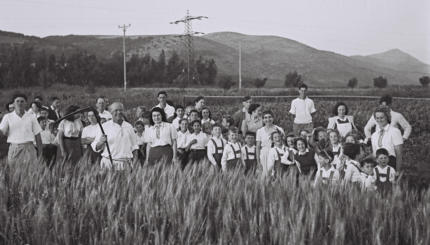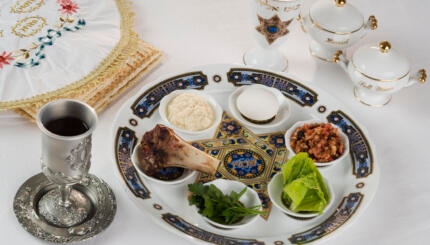The Maggid section of the seder–recounting the story of the Exodus and various interpretations–is very complex, yet vital to the purpose and meaning of the seder. This article highlights certain elements of the Maggid section. It is by no means an exhaustive list of everything that takes place in this section. Reprinted with permission from A Different Night: The Family Participation Haggadah, published by the Shalom Hartman Institute.
The Bread of Poverty
As everyone knows, the Jews eat unleavened bread because the dough they brought out from Egypt in their rush to leave never had a chance to rise. Matzah is then the bread of liberation. It is a mark of an exodus whose rapid pace overtook them unprepared. The Egyptians who enslaved them suddenly expelled them after God brought the plague on the first born.
 Yet “ha lahma” the first official explanation for matzah in the Haggadah, calls it the “bread of poverty and persecution”based on Deuteronomy 16:3, “You shall eat unleavened bread, bread of oni [distress]–for you departed from the land of Egypt hurriedly.” Here matzah is a memorial not of liberation, but of slavery. The life of oppression is marked by a pressured, “hurried” pace, for the slaves do not control the rhythm of their existence.
Yet “ha lahma” the first official explanation for matzah in the Haggadah, calls it the “bread of poverty and persecution”based on Deuteronomy 16:3, “You shall eat unleavened bread, bread of oni [distress]–for you departed from the land of Egypt hurriedly.” Here matzah is a memorial not of liberation, but of slavery. The life of oppression is marked by a pressured, “hurried” pace, for the slaves do not control the rhythm of their existence.
The Four Questions
Why were the Rabbis so insistent that the Exodus story open with a spontaneous question?
With your help, My Jewish Learning can provide endless opportunities for learning, connection and discovery.
First of all, one can view this as an educational device. Teachers know that if they can just get their students to pay attention, get their minds working on something they find interesting, then the teachers have gone a long way towards creating an openness to learning new things. The Rabbis wanted to remind the leaders of the seder not just to focus on the story–but first to make sure to have an active, attentive audience.
On a deeper level, the Rabbis may have reflected that questioning is an essential part of the freedom celebrated on the seder night. The whole Talmudic literature is in the form of questioning and dialogue–not the meek questioning of inferior to superior but the give-and-take interaction of adamant rivals pitted against one another, and sometimes even against God! (8.7: Bava Metzia 59 b)
An essential characteristic of free people is that they notice the world around them, make distinctions and search for meaningful patterns. They want understanding, not inscrutability. For a slave mentality, nothing is “different”–all tasks are part of the same meaningless arbitrariness. There is no point in asking if no one answers, no place for questions in a world where the master’s arbitrary orders are the ultimate justification for the way things are.
In beginning the seder with genuine (not rote) questions, the Rabbis show that we not only tellthe story of freedom, but we act like free people.
The Two Stories
After the youngest child has asked the four questions and everyone else has added their own questions, then it’s time to tell the story that will explain why for us this night is different from all other nights. The Rabbis recommended:
“The parent should teach according to the intelligence and personality of each child. Begin with describing the degradation and culminate with the liberation” (Mishna Pesachim 10: 2).
However, Rav and Shmuel, the Babylonian rabbis, disagreed about the central story to be told at this point in the seder:
Shmuel said: Start with, “We were slaves in the land of Egypt” (Deuteronomy 6:20),and move from physical enslavement to political liberation.
Rav said: Start with Terah, Abraham’s father and the state of idolatry to which we had descended. “Once upon a time our ancestors were slaves of idolatry who worshipped pagan gods, Now–since Mount Sinai–God has brought us close to the Divine service”.
The editors of the Haggadah bring both stories: first Shmuel’s “We were slaves” and later, after the Four Children, Rav’s story.
The Importance of Memory
The Talmud relates that Ben-Zoma felt that the Messianic redemption would wipe out the memories of all previous troubles and rescues. The Rabbis insisted that while the Messianic redemption would be the greater one, we must still recall the earlier ones, including the Exodus.
This argument has to do with the importance of memory. For Ben-Zoma, contemporary events have the decisive weight. Some modern Zionist thinkers like David Ben-Gurion [Israel’s first primer minister] seem to prefer this position, arguing that the founding of Israel has made 2000 years of exilic experience irrelevant. In their view, the Bible, reflecting the experience of a sovereign people in its land, must be the pivotal educating force for Jewish culture, not the Talmud which grew in the shadow of destruction and conquest by the Romans. Similarly, some might argue that the enormity of the Holocaust makes the recalling of all previous sufferings of the Jews seem trivial and irrelevant.
The Rabbis maintained that history should add, but not erase, memories. Recent dramatic historical events may indeed be accorded prominence, but we should never forget our earlier experiences. In their view, even in the Messianic Era–when war, poverty, and human suffering have been eradicated–it will still be incumbent to remember daily the saga of bondage and liberation.
The Four Children
The Rabbisturn the commandment of “ve-heegadta” (“you shall tell”) into a mitzvah of dialogue, with give and take on both sides. Successful dialogue means that each side, and especially the side anxious to “pass on the message,” be keenly attentive to what the other is saying and feeling–to the particular personality and his or her needs.
God’s Promise
After recallingAbraham’s spiritual journey to God and his ascent to Eretz Yisrael [the land of Israel], the Haggadah will recount the descent of his great grandchildren to Egyptian slavery (“The Wandering Aramean”). But first the Haggadah reassures us, as God did to Abraham, that there is a divine pledge to Jewish continuity whatever the ups and downs of history.
The Plagues
 It is a medieval custom to dip one’s finger in the seder’s second cup of wine and to remove 16 drops of wine. As each plague is recited we decrease our own joy, drop by drop, as we recall the enemy’s pain. Besides the ten plagues, the extra six drops correspond to the three prophetic plagues mentioned by the prophet Joel–blood, fire, and smoke–and the three word abbreviation of the ten plagues invented by Rabbi Yehuda–d’tzach, adash, b’achab.
It is a medieval custom to dip one’s finger in the seder’s second cup of wine and to remove 16 drops of wine. As each plague is recited we decrease our own joy, drop by drop, as we recall the enemy’s pain. Besides the ten plagues, the extra six drops correspond to the three prophetic plagues mentioned by the prophet Joel–blood, fire, and smoke–and the three word abbreviation of the ten plagues invented by Rabbi Yehuda–d’tzach, adash, b’achab.
The spilling of the 16 drops has been understood traditionally in opposite ways. Either it signifies sympathy for the enemy Egyptians who suffered as a result of the painful process of liberating the Jews from Egyptian tyranny, or it reaffirms the righteous vengeance of God’s sword exercising judgment against a relentless, cruel, and stubborn oppressor.
Rabbi Yehuda Halevi, the 12th century Spanish physician and poet, explained the division of plagues into twos:
Two plagues from the water (blood and frogs from the Nile).
Two plagues from the earth (lice and wild animals).
Two plagues from air-carried infections (plague and boils).
Two plagues from air-carried damages (hailstorms and locusts).
Two plagues from supernatural acts (darkness caused by an eclipse and the plague of the first born).
Dayyenu: How Much is Enough?
“Had God but split the sea, and not passed us through it on dry land, it would have been enough.” How could it have been enough? Had Israel not escaped through the Red Sea, they would have been slaughtered by the Egyptians!
The point of the poem is to express gratitude for every facet of God’s miraculous deliverance. There is a sense that the Exodus, which reached its fulfillment in the entry into the land and the building of the Temple (a process of over 400 years!) unfolded in many steps, each constituting a miracle in itself. The poet feels the living power of each gesture of divine favor, irrespective of the total result. Had You only done this and no more, it would have been enough for me to feel Your divine love.
The principle of “dayyenu,” of giving thanks even for the partial and incomplete, is crucial for living in this uncertain world in which few dreams ever come to total fruition. We thank God every day for the miracle of being alive. In learning gratitude to God, we also learn to show gratitude to parents, teachers, loved ones, and friends, even when their efforts fall short of completeness.
Rabban Gamliel’s Three Essential Symbols
Before eating the seder’s edible symbols, the Haggadah brings us Rabban Gamliel’s checklist on the three essential foods, whose significance must be understood by all the participants at the seder.
Why these three? The Pesach lamb, matzah, and maror [bitter herbs] constituted the original menu in the Egyptian seder. “They shall eat the meat (of the lamb)… roasted over the fire, with matzah and maror” (Exodus 12:8).
As in a three-act play, Rabban Gamliel identifies these foods with three progressive historical moments in the Exodus:
1) Maror captures the bitterness of enslavement.
2) The Pesach lamb, represented today by the roasted bone (zeroa), recalls the blood on the doorposts and the terror and the anticipation of the night of the plague of the first born.
3) Matzah stands for the following morning, when Israel was rushed out of Egypt with no time to let the dough rise.
Haggadah
Pronounced: huh-GAH-duh or hah-gah-DAH, Origin: Hebrew, literally "telling" or "recounting." A Haggadah is a book that is used to tell the story of the Exodus at the Passover seder. There are many versions available ranging from very traditional to nontraditional, and you can also make your own.
mitzvah
Pronounced: MITZ-vuh or meetz-VAH, Origin: Hebrew, commandment, also used to mean good deed.
Pesach
Pronounced: PAY-sakh, also PEH-sakh. Origin: Hebrew, the holiday of Passover.
seder
Pronounced: SAY-der, Origin: Hebrew, literally "order"; usually used to describe the ceremonial meal and telling of the Passover story on the first two nights of Passover. (In Israel, Jews have a seder only on the first night of Passover.)
Talmud
Pronounced: TALL-mud, Origin: Hebrew, the set of teachings and commentaries on the Torah that form the basis for Jewish law. Comprised of the Mishnah and the Gemara, it contains the opinions of thousands of rabbis from different periods in Jewish history.
Yehuda
Pronounced: yuh-HOO-dah or yuh-hoo-DAH (oo as in boot), Origin: Hebrew, Judah, one of Joseph's brothers in the Torah.


